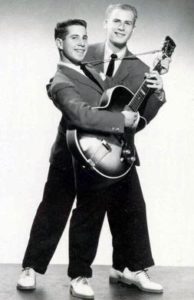 Way back in 1953—one year before I was born (oh my that’s a long time ago!)—this handsome young pair of fellows met in a school in Queens, New York. Paul Simon noticed Art Garfunkel when he sang in a talent show—in fourth grade. They got together and discovered they could make beautiful music together, so they joined and formed a duo called…Tom & Jerry.
Way back in 1953—one year before I was born (oh my that’s a long time ago!)—this handsome young pair of fellows met in a school in Queens, New York. Paul Simon noticed Art Garfunkel when he sang in a talent show—in fourth grade. They got together and discovered they could make beautiful music together, so they joined and formed a duo called…Tom & Jerry.
Tom & Jerry? Don’t ask me! Art adopted the stage name Tom Graph and Paul called himself Simon Jerry Landis. They recorded their first minor hit called “Hey Schoolgirl” that charted at 49 on Billboard and earned them a co-appearance with Jerry Lee Lewis on American Bandstand.
Other attempts at singles didn’t fare well, and their record company Big Records went bankrupt. That was the end of Tom & Jerry.
They went to college as they continued to attempt solo careers, Art as Artie Garr and Paul as both Jerry Landis and Paul Kane, without much success. They decided to get together again, this time as Kane & Garr, and Bob Dylan’s producer Tom Wilson discovered them at a Queens NY nightclub performing at an open mic night. One of the songs was “The Sounds of Silence.”
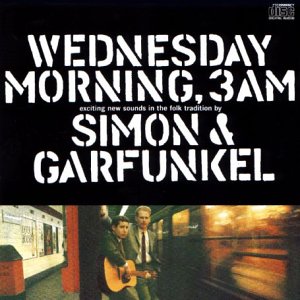
They ended up being signed by Columbia Records and recorded their first album, including some of the songs they’d been performing.
“The Sounds of Silence” was one of those, and it was a clean, unplugged version back then. Even though that one ended up being their break-out song, and even though the album didn’t sell very well, it was chock-full of magnificent folk songs magnificently performed by what would become one of the greatest folk singers of all time.
This time—thank God—they came to their senses and just called themselves Simon & Garfunkel. Simon was adamant about it!
History was in the making, but nobody knew it. The album sold a whopping 3000 copies, and Simon took off for England to do some touring and performing. There he signed with the Oriole label and did some recording. His landlady sent some of them to BBC who took notice, and Oriole got absorbed by CBS, and it looked like Simon was building himself a small career across the pond. He ended up releasing an album called The Paul Simon Songbook that included some songs which later would become Simon & Garfunkel standards, including “I Am a Rock” and “April Come She Will.”
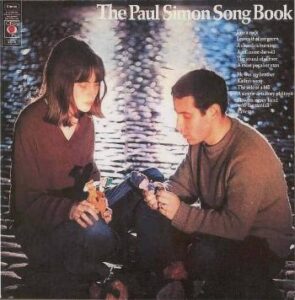 Meanwhile back in America, Tom Wilson on his own produced a remix of what was now called “The Sound of Silence” with electric guitar and bass and drums, and released it as a single. Paul Simon was “horrified” by it, but it became a big hit. My peers and I in those days spent joyful moments discussing what its poetic but mysterious lyrics meant. We wrote school papers on it. Little did we know, the flood of poetry was only beginning.
Meanwhile back in America, Tom Wilson on his own produced a remix of what was now called “The Sound of Silence” with electric guitar and bass and drums, and released it as a single. Paul Simon was “horrified” by it, but it became a big hit. My peers and I in those days spent joyful moments discussing what its poetic but mysterious lyrics meant. We wrote school papers on it. Little did we know, the flood of poetry was only beginning.
The single broke the million sales barrier, and Simon and Garfunkel got back together again in America to produce their second album. This time it was named “Sounds of Silence” (the S was back, but the The was gone.) The duo considered it a rush job, but it introduced important staples of their repertoire like “Homeward Bound” and “I Am a Rock” and established their recurring theme of isolation and the difficulty of communication among human souls.
The album was a great success, and the career of Simon & Garfunkel was well established. Their manager cultivated an aura of mystique around them, keeping their public appearances limited. What the duo cared about, though, was crafting their next album with care, unlike the rush job of “Sounds of Silence,” and having total control over the production. With the success of their last album, they could demand it.
 That next album curiously made four seasonings famous. I had an acquaintance who claimed to have made “Simon & Garfunkel steak” one day seasoned with parsley, sage, rosemary, and thyme. (He said it tasted okay.) I doubt he was the only one who ever came up with that idea.
That next album curiously made four seasonings famous. I had an acquaintance who claimed to have made “Simon & Garfunkel steak” one day seasoned with parsley, sage, rosemary, and thyme. (He said it tasted okay.) I doubt he was the only one who ever came up with that idea.
For me, this album included the most beautiful of all of the duo’s songs: “Scarborough Fair”—and that’s saying a lot, because there’s hardly a song they produced that isn’t beautiful. For decades I just enjoyed the song, but one day I looked up the counter-lyrics going on underneath the sweet Renaissance love song. Turns out there’s an anti-war protest song inside there I never knew about.
After this, Simon got sick of doing singles and developed writer’s block, making the suits at the recording company nervous. But a film director named Mike Nichols came along and stirred things up. He was mesmerized by their music and wanted to use it for his upcoming film The Graduate. Simon felt like he’d be selling out until he met Nichols and read the screenplay. He wrote “Punky’s Dilemma” and “Overs” for the film, but Nichols didn’t like them. Instead Simon offered up an incomplete song that appealed much more to the director.
Ever since I first saw The Graduate, I wondered why the song “Mrs. Robinson” was so poorly represented in the film. It just included the guitar and all the dee-dee-dee’s and doo-doo-doo’s. Now I know why. It hadn’t been finished yet! Well, it’s finished now, so we can hear its lively music and biting satirical lyrics in all their glory.
One thing that amazes me about it is, there are nothing but acoustic guitars ad some kind of percussion playing in this song, yet its instrumental accompaniment is quite sophisticated. You don’t even miss all the other instruments that are usually included in popular songs. These are some masters at work.
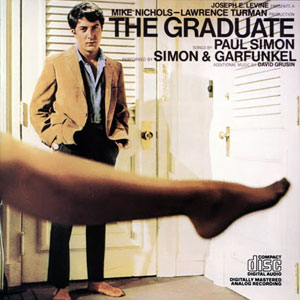 Of course a movie soundtrack album was released, but the next Simon & Garfunkel album was Bookends. They took two years to painstakingly record this one, striving for perfection, going in a new direction from “Mrs. Robinson” and throwing in instruments they were not known for using.
Of course a movie soundtrack album was released, but the next Simon & Garfunkel album was Bookends. They took two years to painstakingly record this one, striving for perfection, going in a new direction from “Mrs. Robinson” and throwing in instruments they were not known for using.
It was during this period that Simon began contemplating the break-up of the duo, wanting to go solo. But the album sold like gangbusters thanks to the success of The Graduate, even though it debuted the day before Martin Luther King was assassinated. They were at the top of their profession, considered by many to be the best singing duo of their time. Lots of offers came in to collaborate on film projects that they turned down, plus a chance to work with Leonard Bernstein to compose a mass, which Simon tried, but found it too out of his comfort zone.
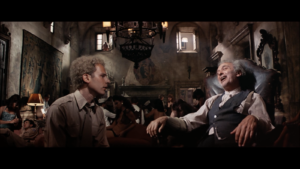 This was when Art Garfunkel decided to try his hand in film acting with Catch 22. He went on to appear in a few other films, but his acting career never quite took off. His excursion into film put more strain on their relationship, in part because it delayed producing their next and what would turn out to be their last album, Bridge Over Troubled Water.
This was when Art Garfunkel decided to try his hand in film acting with Catch 22. He went on to appear in a few other films, but his acting career never quite took off. His excursion into film put more strain on their relationship, in part because it delayed producing their next and what would turn out to be their last album, Bridge Over Troubled Water.
But if you’re going out, you want to go out in style, and holy moley they did! Bridge was a perfect farewell masterpiece with nary a single dud in its tracks. The eponymous song plus “The Boxer” and “Cecelia” became well known, but the entire album was the crowning achievement of their impressive career. It was the best selling album for three years and the best selling album ever until Michael Jackson came along with Thriller. It won six Grammy Awards in 1971 including Album of the Year and Song of the Year, a Grammy Hall of Fame Award in 1998, and in 2003 they won the Grammy Lifetime Achievement Award.
I’d love to share every Simon & Garfunkel song that’s dear to my heart, but that would run into the dozens, and who would listen to all of them? It was painful to choose only one per album, and especially to leave out so many lesser known gems that I’d love to highlight. The pain is greatest with Bridge because, for heaven’s sake, which one do I pick? They all deserve to be shared.
So I didn’t even try to choose based on merit. I shared the song “Bridge Over Troubled Water” because it was the pinnacle song of their career, but as for the rest in the album, I also decided to go with the one that wraps up the album and the journey of one of my all time favorite musical performing groups. They came back to do some reunion performances, most notably the Central Park concert and their appearance on Saturday Night Live, which was magic, but there would be no more new Simon and Garfunkel songs with the dizzying talent of Simon’s songwriting and the silky smoothness of Garfunkel’s tenor voice.
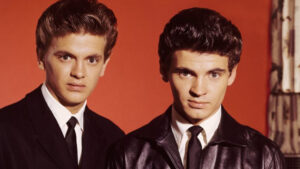 At the beginning of their career, they were influenced heavily by the Everly Brothers whom they idolized. The final recorded song of Simon & Garfunkel is “Bye Bye Love,” a hit song recorded by the Everly Brothers, which Simon & Garfunkel performed live to an audience as if they were back at the open mic in Queens. It segues into a sort of goodbye to us from Paul Simon, who seems to be handing his career of music with his friend and colleague Art Garfunkel over to us for safekeeping, packaged up and wrapped in a pretty bow, a gift of 14 years of some of the finest folk music the world could ask for:
At the beginning of their career, they were influenced heavily by the Everly Brothers whom they idolized. The final recorded song of Simon & Garfunkel is “Bye Bye Love,” a hit song recorded by the Everly Brothers, which Simon & Garfunkel performed live to an audience as if they were back at the open mic in Queens. It segues into a sort of goodbye to us from Paul Simon, who seems to be handing his career of music with his friend and colleague Art Garfunkel over to us for safekeeping, packaged up and wrapped in a pretty bow, a gift of 14 years of some of the finest folk music the world could ask for:
Here is my song for the asking
Ask me and I will play
So sweetly I’ll make you smile
This is my tune for the taking
Take it don’t turn away
I’ve been waiting all my life
Thinking it over I’ve been sad
Thinking it over I’d be more than glad
To change my ways for the asking
Ask me and I will play
All the love that I hold inside
And with that, Simon & Garfunkel was no more.
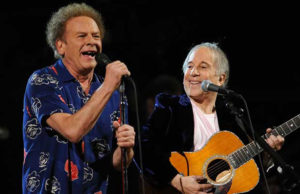
But Paul Simon and Art Garfunkel still are. Art went on to record several beautiful songs in his beautiful voice. And Rhymin’ Simon keeps cranking out astonishing music that defies categorization, defies comparison with anyone else, and keeps us guessing what his enchanting lyrics mean.
But those are stories for another day.
I love, love, love Simon and Garfunkel. This was a fun read.